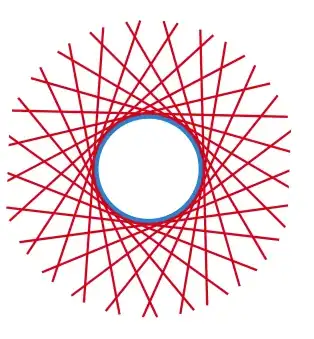Suppose $M \subset \mathbb{R}^n$ is a submanifold. Then one may define its tangent bundle to be the union of all the tangent vector spaces $T_pM$ to $M$ at points $p$. The problem is what is to be understood as "union" here.
Suppose you define it to be the union as subsets of $\mathbb{R}^n$.
For example, if $M = \mathbb{R} \subset \mathbb{R}$, then at each point the tangent space is $\mathbb{R}$, so all the tangent subsets are equal to the same subspace of $\mathbb{R}$, namely $\mathbb{R}$, and so is their union.
Now suppose $M = \mathbb{S}^1 \subset \mathbb{R}^2$. Then any vector line $D$ can be seen as the tangent space of a point of the circle. So here, the usual union as subsets of $\mathbb{R}^2$ will be the union of all vector lines of $\mathbb{R}^2$, which is $\mathbb{R}^2$.
These constructions are "extrinsic" as they depend not only on $M$ but also on the ambient space $\mathbb{R}^n$. For example, if one says $M \subset \mathbb{R}^n \simeq \mathbb{R}^n\times\{0\} \subset \mathbb{R}^m$, then one can define a "different $TM$", depending on the viewpoint (even if they will be isomorphic).
But in these two examples, if you take a random element of the union, you don't know at which point it is tangent. You lose a lot of geometric sense.
The idea to avoid this is to take a disjoint union, namely
$$TM = \bigcup_{p\in M} \{p\}\times T_pM.$$
An element of this union is of the form $(p,v)$ with $v \in T_pM$, so each element has in its construction more data than in the previous example.
For the first example, this construction gives $T\mathbb{R} = \bigcup_{p\in\mathbb{R}} \mathbb{R} = \mathbb{R}\times \mathbb{R}$, and any tangent vector is of the form $(x,t)$ where $t$ is tangent to $x$.
For the circle, it gives $T\mathbb{S}^1 = \bigcup_{\theta \in \mathbb{S}^1} \{\theta\} \times T_{\theta}\mathbb{S}^1$, etc.
For an abstract manifold, there is no "ambient space", so the usual union of the tangent spaces cannot be defined as an union of subspaces of the same fixed set. Therefore, it would have been a bad construction as we would not have been able to extend it. But the disjoint-union allows us to define, for a general manifold $M$ that is not embedded in a Euclidean space,
$$T_pM = \bigcup_{p\in M}\{p\}\times T_pM,$$
where $T_pM$ is an intrinsic notion in $M$, depending only on the differential structure.
In addition, this construction shows that there is a natural structure of fiber-bundle on the tangent space $TM$ (this is a more general concept), and this construction automatically gives a smooth function $\pi : TM \mapsto M$ that is just the projection $(p,v) \mapsto p$.
If one wants to define a vector field by the idea that "at each point $p$ it has a tangent vector to $p$", then it can be rigorously defined using this construction as a continuous map $X : M \to TM$ such that $X(p) = (p,v_p)$. This is equivalent to saying that $X$ is a (continuous) section of $\pi$, that is $\pi\circ X = \mathrm{id}_M$.
Usually we require the vector field to be smooth, which means $X$ is smooth (a smooth section).
Edit: It is a common problem for geometers, when they have to give a talk to non-specialists, to give a clear presentation while the audience has no idea of the principal objects we use, such as manifolds, vector bundles, etc. My experience is this: do not lose time giving overly complicated definitions if what is really important is the geometric sense. Just say that a manifold is a geometric notion that can extend the definition of surfaces, etc. Define tangent vectors visually. Say that a tangent field is a field of tangent vectors without talking about bundles. Same for covectors. If you have to talk about operators in bundles, just talk about how they act on vectors. You will gain a lot of time and the audience will probably understand many more things than if you had given some overly complicated rigorous statements.
